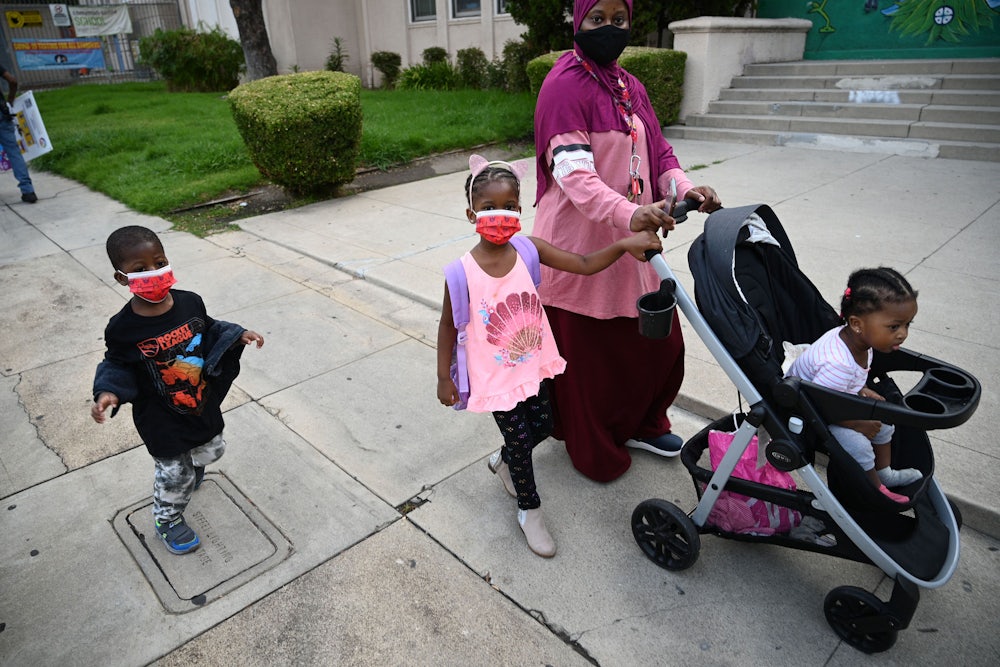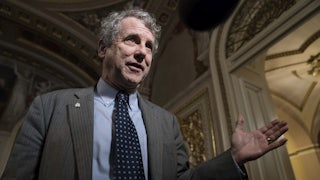In debates over publicly funded childcare, conservatives and liberals alike trumpet the importance of giving parents the ability to send their children to the preschool or day care of their choosing. It’s an ideal fueled by the conviction that when it comes to childcare, no one knows what young kids need better than their parents. And yet, study after study suggests that parents are, in fact, lousy consumers of childcare. They are poor judges of quality even when their kids have been in a program for months, much less on a 30-minute tour taken a few weeks postpartum. Add to this that low-income parents enrolling in subsidized care often must make quick decisions with limited information, and picking childcare—one of the most momentous decisions a new parent faces—begins to look a lot like pin the tail on the donkey.
Even if parents could recognize stellar childcare on the spot, chances are their kids won’t get it, and almost certainly not of the variety that fits their schedules, pocketbooks, and locations. There is simply not enough high-quality care to go around. In truth, parents have never had much choice in childcare; for most U.S. families, it’s take what you can get. The idea of parents being in control of the standard of care their kids receive is, at best, a fantasy that allows everyone to feel a little better about babies spending days in mediocre arrangements. At worst, it absolves lawmakers from the responsibility of offering anything more than a hodgepodge menu of options that can be funded on the cheap.
The Build Back Better bill being hammered out in Congress proposes a number of important steps to address quality, including fair wages for a workforce that makes so little money that more than half of it relies on some form of public assistance. This would be huge in helping programs retain and recruit effective early educators. It’s not easy to offer top-notch care to other people’s kids when you’re worried about feeding your own.
The bill promises a big improvement over our current system, but policies based around preserving parent choice won’t create high-quality childcare. They will expand our patchwork system based on the needs of parents and their employers rather than children. And our current choice system—which straddles everything from small programs offered out of providers’ living rooms to corporate-chain childcare centers—does a pretty poor job even at meeting parents’ needs. Just as the pernicious emphasis on “choice” through charter schools and vouchers undermines the public school system, the relentless mantra of preserving choice in childcare thwarts efforts to create the kind of option that would offer kids consistently decent care.
A sad truth about childcare in the United States is that fewer than 10 percent of early education settings are considered high quality—a definition that includes easily observed things like small group sizes and a safe, clean space with age-appropriate toys and books but also the murkier measure of whether teachers offer warm and responsive caregiving, such as asking open-ended questions, following kids’ lead in conversation and play, and comforting children in distress.
Trained observers rate most programs in the U.S. as only fair, and the rest as low quality, according to one of the most comprehensive studies on the subject, a finding that has been echoed in research since. Children from low-income families—the ones who may stand to gain the most from high-quality care—routinely wind up in lower-quality programs.
But you’d never know this talking to parents. In a 2016 national poll, 88 percent of families with young children ranked their childcare “very good” or “excellent.” A 2018 analysis of nearly 50,000 Yelp reviews and ratings of childcare businesses in 40 large cities found more than three-fourths of parents gave their providers five-star ratings. And in two studies surveying low-income families receiving subsidized care, mothers overwhelmingly expressed satisfaction with their programs, with 74 percent of one sample rating their child’s program as “perfect” or “excellent.”
One explanation for this disconnect is that parents desperately need childcare, so they’re primed to be grateful for whatever gets them to their work sites on time. Or parents’ quality inflation could be a cognitive dissonance born of guilt, anxiety, and even a clear-eyed desire to appear responsible parents in surveys—after all, none of us want to believe, much less tell others, that we’re leaving our kid in a subpar program.
There’s also the possibility that parents value different aspects of childcare than the trained professionals. Observers zero in on kids’ experiences, said Katie Albitz, public policy and advocacy coordinator for the New York Association for the Education of Young Children, while parents must make far more complicated assessments that weigh in factors such as tuition, hours of operation, location, and personal preferences such as languages spoken and whether a parent feels a connection with the teachers.
Meanwhile, child development, and a daycare’s impact on it, plays out over the long term and isn’t something parents can evaluate on a day-to-day basis. Which is to say, it’s far easier to compare two different programs by cost and distance from one’s apartment building—all readily quantifiable—than by their intangible dimension of quality.
The most direct remedy is to take the onus of choice off the parents. Follow the public school model and provide parents with a readily available childcare option with set staff salaries and quality standards. Quebec’s universal childcare program is a case study of this: Its publicly funded network of highly regulated nonprofit centers with set parent fees is considered by researchers to be far higher quality than the province’s offerings of private for-profit programs, according to research by Pierre Fortin, an economist at the University of Quebec. The Defense Department uses a similar standardized model to offer military personnel reliably quality childcare.
The Build Back Better bill does not envision a public option. Instead, it builds on our sprawling market system, infusing existing childcare programs with what Daphna Bassok, professor of education and public policy at the University of Virginia, calls “baseline funding” that would allow them to “function and be more stable.” Right now, said Bassok, the childcare sector is experiencing such a debilitating worker shortage, brought on by low pay coupled with the pandemic, that “the idea that centers could be responsive to demands” from the market is a pipe dream. In most places, parent tuition alone was never sufficient to run a high-quality program.
On the family side, the Build Back Better plan provides parents with generous subsidies to put toward programs of their choosing. But to spark what Chris Herbst, a professor at Arizona State University who studies childcare policy, envisions as a “quality revolution in the market,” parents would have to use this bolstered purchasing power to create demand for high-quality programs, which Herbst believes would incentivize improvements across the sector. And for that to happen, policymakers need to concede that early education expertise is not some latent instinct that kicks in at childbirth. “We expect too much from parents,” Herbst said. They need help.
Over the past two decades, some states have created
publicly available childcare rating systems that aim to make parents better-informed childcare
consumers by ranking programs’ quality, often using a simple five-star ranking.
These kinds of rating systems have equity
issues that need attention, but in some cases they have driven change in childcare programs at scale. In Louisiana,
the number of subsidized childcare
programs meeting that state’s quality proficiency standards jumped from 40 percent to 73 percent during the first four
years after the rating system’s launch. In North Carolina, where close to 90
percent of licensed providers participate in the rating system, fewer people
enrolled in programs with lower ratings in areas with plentiful childcare options,
suggesting the ratings spurred parents to choose higher-quality programs.
But that caveat about plentiful childcare options in the study carries a cautionary tale: In neighborhoods where childcare was scarce, enrollment in low-quality programs held steady. That is, even when working parents know their childcare options are suboptimal, their kids still need to go somewhere.
Which is to say, giving parents more information will make rhetoric around parent choice more meaningful. But in our current system, too few of the offerings are good.








